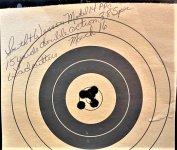StrawHat
Member
Trooper Joe,
I generally like what you are writing. I don’t always agree with it but it is usually well thought out.
My background, I wore a badge for about a decade before I quit. I competed in PPC before, during and after that time. As you may know, PPC involves multiple courses of fire with ranges from 7 to 50 yards. I do not know of any winning competitor who used single action in any of the courses. I met many new shooters who used single action at first but those who stayed with it all “converted” to double action.
I have quoted some of your writing that I felt needed commentary.
Joe, if you have a revolver that is not functioning properly, it needs to be repaired.
And for you, that is appropriate. For me, I will use the double action feature that I am most comfortable using.
Careful, it sounds like you are trying to say single action is the only way to shoot!
Some folks can learn one or the other. Some can handle both. It is good that we have options.
Kevin
I generally like what you are writing. I don’t always agree with it but it is usually well thought out.
My background, I wore a badge for about a decade before I quit. I competed in PPC before, during and after that time. As you may know, PPC involves multiple courses of fire with ranges from 7 to 50 yards. I do not know of any winning competitor who used single action in any of the courses. I met many new shooters who used single action at first but those who stayed with it all “converted” to double action.
I have quoted some of your writing that I felt needed commentary.
…
To this day, I still occasionally find that the double action mode on some revolvers doesn’t seem to be as positive as the single action method…Trooper Joe
Joe, if you have a revolver that is not functioning properly, it needs to be repaired.
…I agree that double action should probably be used for close range encounters. However, if the distance is greater and especially if you are enjoying some cover, I would find myself using the single action mode…Trooper Joe
And for you, that is appropriate. For me, I will use the double action feature that I am most comfortable using.
…I just feel that some “experts” are suggesting that even in non defense types of situation ( maybe 20 yards plus, hunting scenario’s) that double action is the only way to properly use a da/SA revolver
…Trooper Joe
Careful, it sounds like you are trying to say single action is the only way to shoot!
Some folks can learn one or the other. Some can handle both. It is good that we have options.
Kevin


